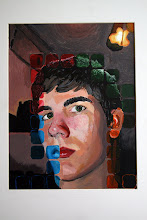I feel like posting in different ways so this week Im going to post like a Q & A survey you would see in an article.
Anne Frances Wysocki- Given what you’ve read, what seems to you most important — in general — to keep in mind while arranging type on a page or screen?
Matthew Charles Cisz- What isnt important when considering type arrangement on a page or screen! Well first of all, if your talking about page or screen you need to take into consideration screen based fonts like georgia for instance, which was designed for the screen. Nowadays just about any font works whether you are dealing with screen or page. Now other than categorizing you have to think about the leading of the type, which means how much space you want to have in between each line. You also have kearning which alters the space between two given characters, but it should not be confused with tracking! Tracking controls the space in between all characters, or the characters selected. You could also talk about how you want the type aligned whether it be justified, center, align left or align right, it all depends on what your purpose is. Other than that there are endless possibilities when it comes to font choices and weights and sizes but thats a whole other topic!
AFW- Given what you read, what are the 4-5 specific guidelines or suggestions that you will most try to apply as you work with type on page or screen?
MCC-5 words. Leading. Tracking. Kearning. Typeface. Size. Weight. Opps that was six, oh I lied I appologize Anne. That is limiting options of words to the max, there are so many other guidelines to follow.
AFW-Was there anything in the readings that surprised you? Anything that you think should have been in the readings but wasn’t?
MCC-Well well well, I dont think anything surprised me, but just the repitition of type basics and pounding them into my thick skull! Oh and I couldn't be more pleased.
Thank you for the links, most of them are in my bookmarks now!
Monday, September 28, 2009
Thursday, September 24, 2009
repetition vs non-repetition
With more repetition in shape it is harder to determine a focal point, and less likely to be a recognizable shape.
Balance in white space is also affected if you have a pattern. The more pattern you have the less white space you will have.
With less repetition in a pattern, it is clear which is the figure and which is the ground, whereas the repetitive pattern usually harder to tell which one should be focusing on.
Amanda Throm
Matt Cisz
Scott Lambert
Balance in white space is also affected if you have a pattern. The more pattern you have the less white space you will have.
With less repetition in a pattern, it is clear which is the figure and which is the ground, whereas the repetitive pattern usually harder to tell which one should be focusing on.
Amanda Throm
Matt Cisz
Scott Lambert
static vs. dynamic
static
-static compositions usually have straight horizontal or vertical lines.
-stable figure ground relationship
dynamic
-diagonal lines create movement through the piece
-curved, organic shapes create movement
-negative shapes help with movement
-variation in line weight
-breaking the plane creates visual tension
post was completed by
-matt
-chad
-laurie
-static compositions usually have straight horizontal or vertical lines.
-stable figure ground relationship
dynamic
-diagonal lines create movement through the piece
-curved, organic shapes create movement
-negative shapes help with movement
-variation in line weight
-breaking the plane creates visual tension
post was completed by
-matt
-chad
-laurie
Tuesday, September 15, 2009
Figure and Ground Discussion
Ways to identify figure and ground
*Balance of color
*How recognizable the object is
*Controlled white space
*Creating visual tensions, breaking the edge
*Scale of objects in composition
*Positive and negative space and objects / inverse objects
*Balance of color
*How recognizable the object is
*Controlled white space
*Creating visual tensions, breaking the edge
*Scale of objects in composition
*Positive and negative space and objects / inverse objects
Figure and Ground
Figure and ground are two things that every composition must have and for the most part are easily identifiable, but sometimes they can trick the human eye. Figure and ground have a pretty simple explanation. The figure of a composition is the object or form being shown, and the ground is the space around it. If we were to look at a portrait photograph of a person, the person would be the figure and the background whether it be the outdoors or a plain sheet would be the ground. It is important in visual communication to have figure and ground relations, because without it communication and design would be at a loss, there would be no focal point. To ask myself how I will use these in my own work is kind of a silly question, because I already use them in my work and will continue to do so in the future. In most of my current layouts the black is the figure and the white is the ground
Whoops accidently posted to my other blog! so here it is.
Whoops accidently posted to my other blog! so here it is.
Subscribe to:
Posts (Atom)
